What Is a Resource Breakdown Structure (RBS)?
A resource breakdown structure (RBS) is a hierarchical chart that lists and sorts all the resources required for a project. It breaks down resources (people, equipment, materials, and services) by type and function, so you can allocate them throughout the project lifecycle.
Teams can easily create and share an RBS using tools such as Excel. Most teams present the chart as a tree diagram.

RBS diagrams are a foundational part of resource planning, which you can learn about in this guide to resource planning in project management. These concepts are almost always included in PMP (Project Management Professional) exams, so it’s an essential concept to understand if you’re preparing for certification. Find additional tips and practice in this roundup of PMP study guides.
How an RBS Differs From a Work Breakdown Structure (WBS)
An RBS and a work breakdown structure (WBS) are different but complementary tools. An RBS focuses on who or what is needed for a project. A WBS focuses on what needs to be done. Both are used together to improve project planning and resource allocation.
An RBS organizes all project resources by type, such as personnel, equipment, and materials. A WBS, on the other hand, outlines the actual work involved. The latter starts with the overall project objective, then breaks down that objective into four progressively smaller levels: phases, deliverables, tasks, and subtasks or activities.
Learn more about how to use a WBS in this complete guide to work breakdown structures or by downloading one of these helpful work breakdown structure templates.
“Think of WBS as your to-do list — all the work that needs to be done as per agreed terms,” says Thyagaraj K, Contracts and Planning Engineer at Gravity Designers & Interiors. “Now think of an RBS as your who/what list, in which people, materials, and machines are needed to do that work. Use them together like a recipe: WBS shows the steps, RBS lists the ingredients.”

Once you’ve connected the RBS and WBS, you can create a responsibility assignment matrix (RAM) or a RACI chart, which clearly shows who is responsible for what across the project.
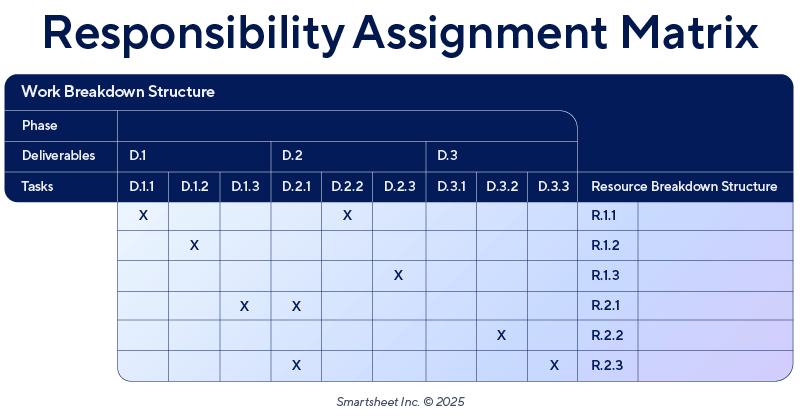
Create your own responsibility assignment matrix with this guide to RACI charts.
What’s Included in a Resource Breakdown Structure?
An RBS includes all the resources required to complete a project. This typically includes human resources, equipment, materials, facilities, and services or vendors. You can break down each category further to show specific resource types — this makes it easier to allocate resources throughout the project lifecycle.
For example, you can organize human resources by role (such as project manager, designer, or developer) or by department (such as marketing, engineering, or operations). Because cross-functional teams often work together to execute a project, consider and include the full range of resources from every team involved. That means not only labor, but also tools, materials, and shared services each team depends on.
Why Use a Resource Breakdown Structure?
An RBS helps project managers organize, allocate, and monitor resources effectively by providing a clear, visual hierarchy of all resources involved in a project. Using an RBS improves planning accuracy, supports cost estimation and budgeting, and reduces the risk of resource overallocation or shortages.
“Without a RBS, we’re just guessing what resources are needed,” says Thyagaraj. “With one, you can plan who’s needed where, avoid overbooking your teams, and keep your costs under control.”
Here are some important benefits of creating an RBS:
- More Accurate Budgeting: An RBS helps project managers estimate costs more precisely by identifying every resource needed before work begins.
- Clearer Team Roles and Responsibilities: Organizing human resources by role or department makes it easier to assign tasks and prevents overlaps.
- Better Resource Allocation: By mapping all resources visually, teams can avoid overbooking or underutilizing equipment. Learn more in this beginner’s guide to resource allocation.
- Improved Scheduling and Planning: With a full view of resource availability and needs, project managers can build more realistic timelines and phase work efficiently across departments and teams. You can also use one of these free resource planning templates as a complement to your RBS.
- Smarter Risk Management: Knowing exactly what’s needed and when helps teams anticipate resource shortages or dependencies before they cause problems.
Find a roundup of useful resources to help you optimize resource management using Smartsheet in this resource management guide.
How to Create a Resource Breakdown Structure: Step-by-Step Guide
To create an RBS, start by downloading a template. Define the project scope, list all required resources, group resources by category (such as people, equipment, or materials), and break down each group into specific roles or items. Then build a hierarchical chart to visualize the structure.
Once you’ve completed your RBS, review it with your team to support planning, budgeting, and resource allocation. Tools such as Smartsheet help manage this process collaboratively.
Here’s a step-by-step guide to help you create an effective RBS:
1. Define Project Scope
Start by identifying the overall goals, key deliverables, and major milestones of the project.
One good way to approach this step is to review the project charter or statement of work (SOW) to clarify expectations and avoid scope creep later. Find other tips in this guide to project scope management.
2. Identify Required Resources
Make a complete list of all resources needed to execute the project. This includes human resources (e.g., engineers, designers, project managers), physical assets (e.g., hardware or equipment), materials, facilities, time, and money.
Be sure to think across departments and functions. For example, a software project might require developers, QA testers, cloud infrastructure, budget for licenses, and even language specialists for a multilingual product. Don’t overlook support roles or external vendors that are critical to delivery. Consult with various departments and stakeholders to ensure that you don’t overlook anything.
3. Group Resources by Category
Once you’ve compiled your list of resources, organize them into logical categories. Some common categories include human resources, physical resources, facilities, services, and vendors.
4. Break Down Each Category
Break down each high-level resource category into more specific components. For example, under “Human Resources,” identify the individual roles or teams required to complete the work.
Here are some common examples of resource categories and typical items:
| Category | Examples |
|---|---|
| Human Resources | Developers |
| Physical Resources | Laptops |
| Facilities | Office space |
| Services and Vendors | External consultants |

Pro Tip: When working with external teams or managing complex deliverables, many teams build a comprehensive and granular RBS. “When working with agency partners, we don’t just break things down by function such as development, design, or strategy. We also categorize by skill level, technical proficiencies, and even language skills that clients ask for,” explains Gianluca Ferruggia, General Manager at DesignRush. “This level of detail means we never short-staff critical phases, whether it’s launching a multilingual website or running a specialized ad campaign that needs expertise with a specific platform.”
5. Download an RBS Template
Download a basic resource breakdown structure template and save it using your usual file naming conventions.
6. Add Resources to the Chart
Click into the text box at the top of the template to enter your project title. Then, update each resource category (Personnel, Equipment, Materials) and fill in the corresponding resource names below them as needed.
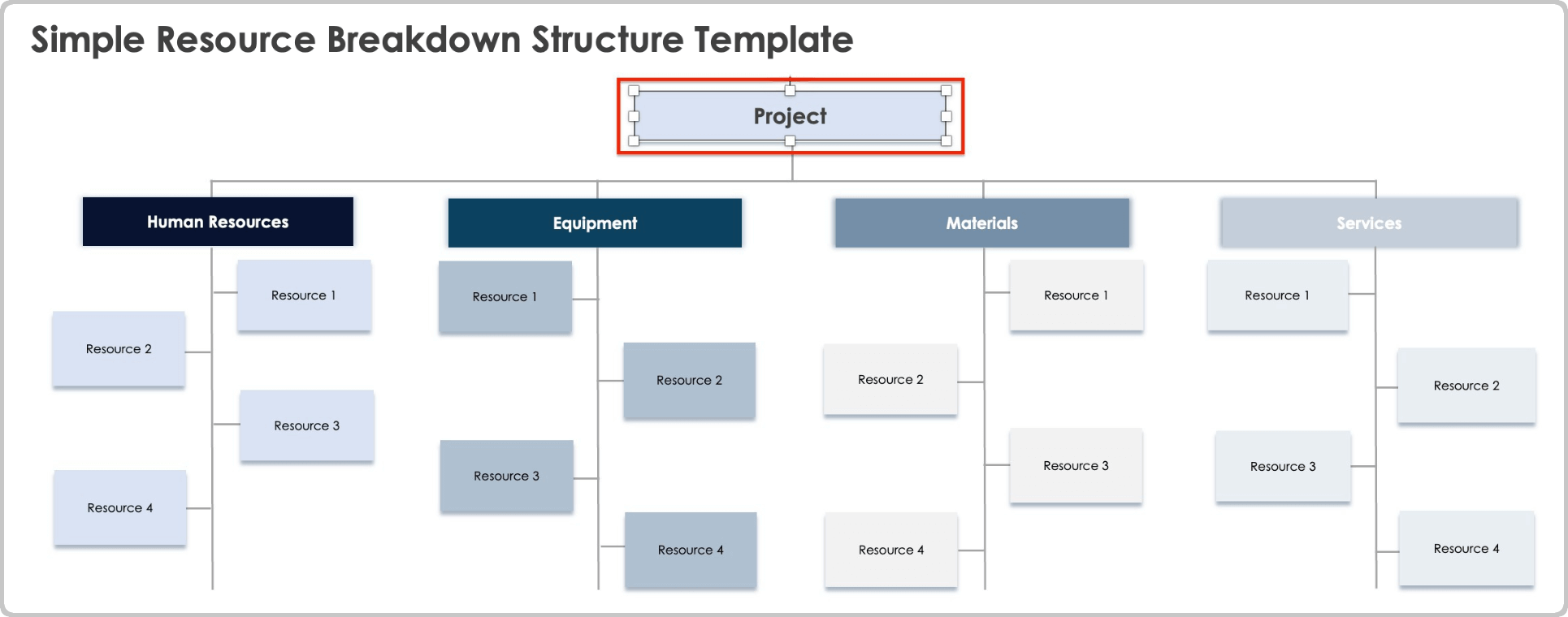
7. Add or Remove Resource Boxes
To move a box or connector line, hover your mouse over it until the four-headed arrow appears. Click, drag, and drop it into place.
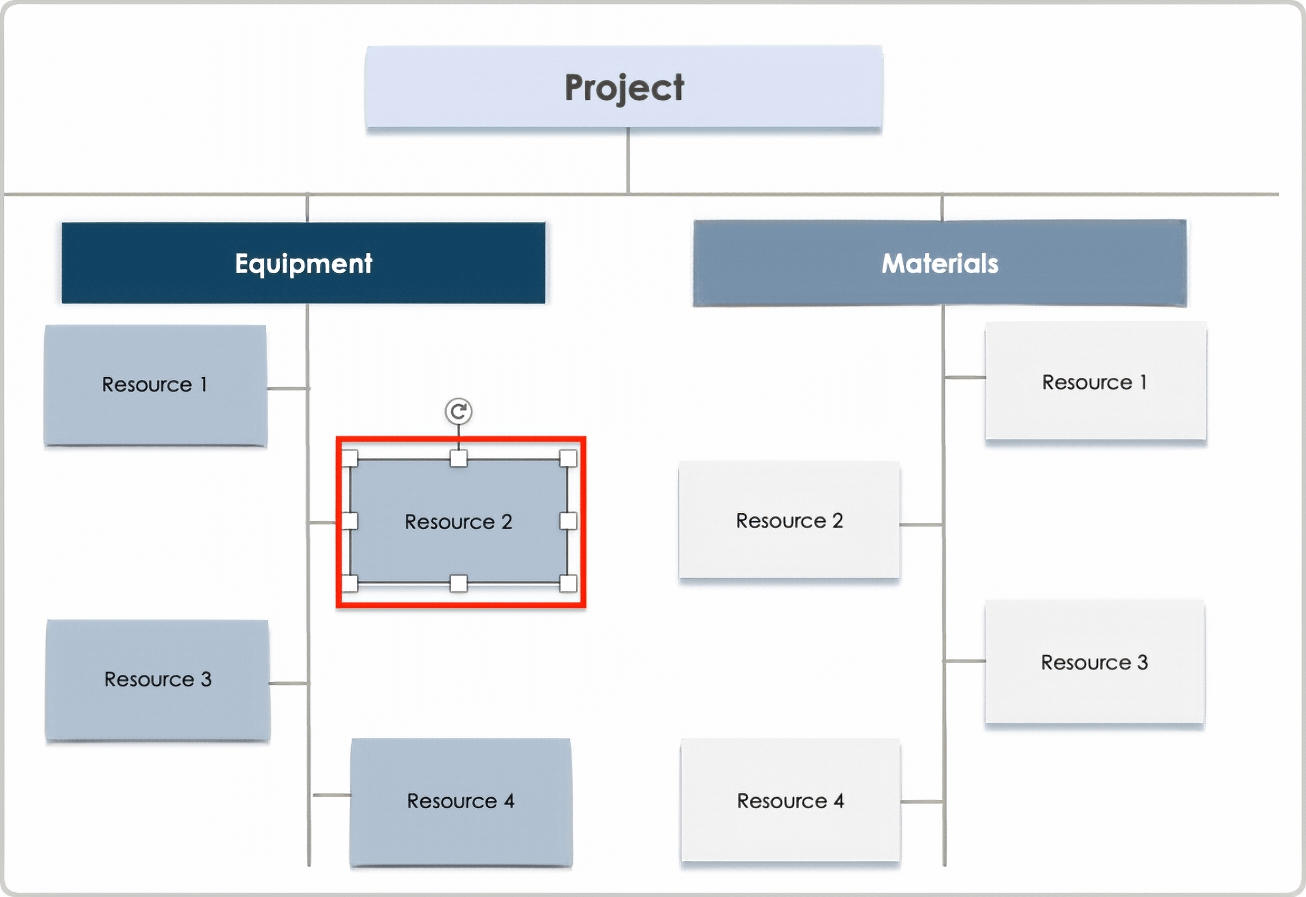
The template comes with four resource boxes for each category. If you need more, add a new resource box by copying and pasting an existing box, and reposition it in the tree.
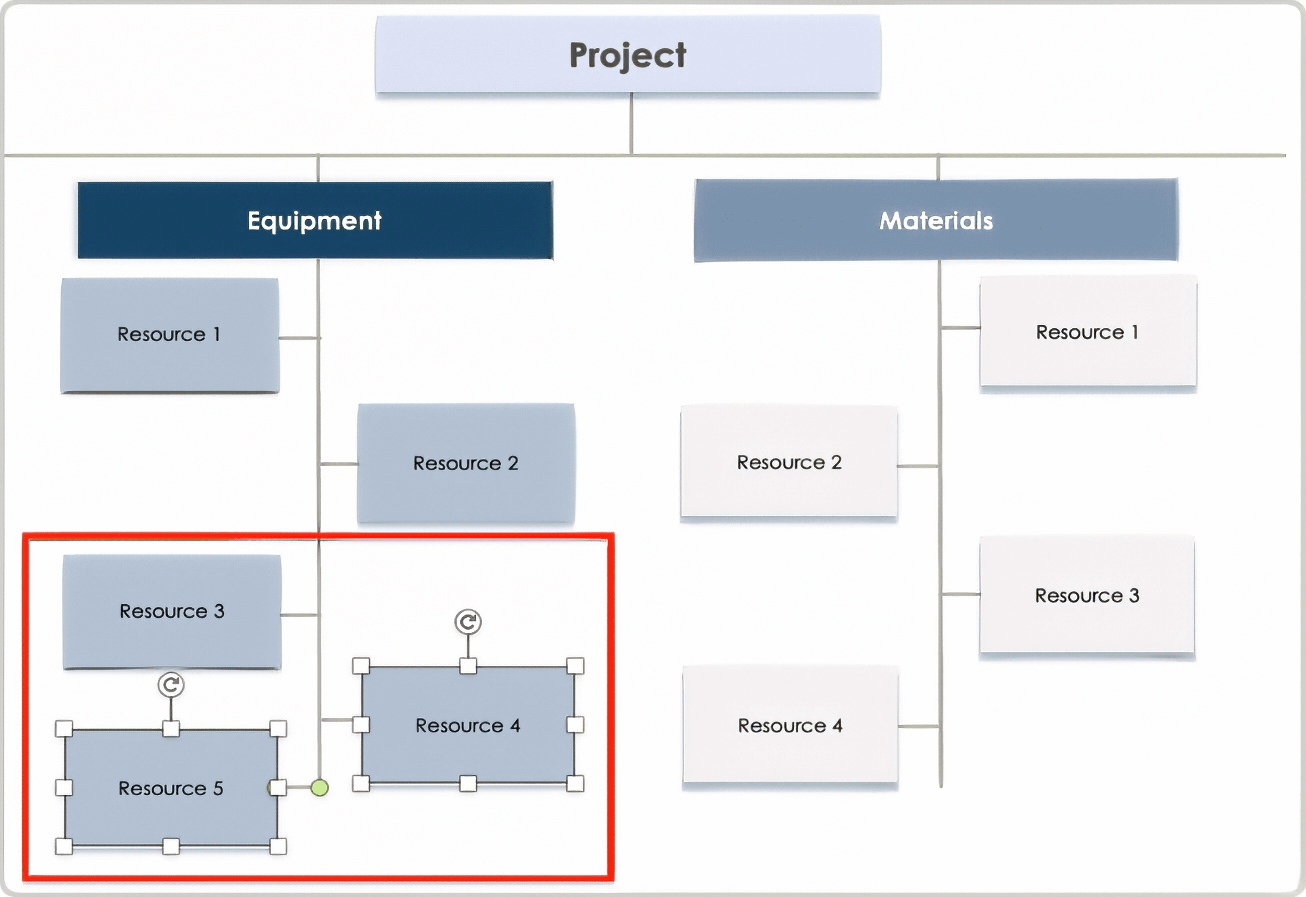
To delete a box, click it and press the Delete key. Adjust connector lines as needed to maintain the structure.
8. Review and Validate
Once your RBS is complete, review it with key team members and stakeholders. Be sure to validate not only the core resource categories, but also supporting areas that are often missed, such as testing, training, documentation, and post-launch support.
Now that you have a functional RBS, use it to guide your project execution.
“If you want your RBS to really drive project success, rather than just exist for the sake of process, move away from spreadsheets as soon as collaboration gets complicated,” advises Ferruggia. “Choose a platform that can scale with you and supports focused, role-based teamwork. Doing this has made a clear, measurable impact on how we scale and deliver successful projects.”
Many teams use tools such as Smartsheet to connect their RBS directly to their project plan. This makes it easier to visualize how resources are distributed across phases and adjust them in real time. Remember: An RBS isn’t just a planning document; it should evolve alongside the project.
Using AI to Help Create Your RBS With Sample Prompts
AI can be a powerful assistant when building an RBS, especially during early stages. For example, you can ask an AI to generate a starter list of common resources based on your project type, or feed in an existing WBS and prompt the AI to suggest what resources are typically needed for each task. You can also ask an AI to organize a rough resource list into a clean, hierarchical format.
Here are a few sample prompts to try:
- “Here’s our WBS for a website redesign. What resources would we typically need for each task?”
- “This is our draft list of resources. Can you group these by category: human, physical, services, and facilities?”
- “Give me a sample RBS for a mobile app development project, broken into categories and roles.”
Thyagaraj has experimented with using AI when creating resource breakdown structures and finds it helpful. “I’ve used AI to suggest resource lists based on project type,” he said. “It saves time and gives a solid starting point, but no AI can replace real-world experience. It’s helpful as a tool — not as a planner.”
Common Mistakes to Avoid When Using RBS
When using an RBS, avoid mistakes such as creating complex hierarchies, failing to validate resource needs with stakeholders, and relying on static tools. Experts and researchers warn that unclear instructions, technical jargon, and poor communication can impede success.
In the 2022 study, “Improving Project Communications Management Practices in the Construction Sector during the COVID-19 Pandemic: A Malaysian Scenario,” researchers named RBS as one of 11 key communication channels used in construction project communication management. But they also flagged it as a potential barrier.
They noted that overly complex RBS methods, technical jargon, and delays in communication from upper management hindered understanding and efficiency. To address these issues, they recommended using clear, simplified instructions, quickly disseminating RBS information, and incorporating multilingual strategies to improve comprehension across teams.
Here are some common mistakes to avoid when creating and using your RBS:
- Overlooking Resources: Your core project team won’t be the only contributors to your project’s success. Make sure to include resources from supporting departments (e.g., legal, marketing, IT), as well as third-party providers who may play critical roles in delivery or support. In addition, be sure to account for testing and training needs, which can be significant time and resource commitments — especially in software or change management projects.
One easy way to guard against this is to validate with stakeholders, such as department leads or subject matter experts. - Overcomplicating Hierarchy: While detail is good, an overly complicated RBS can become difficult to maintain. Balance granularity with usability.
- Failing to Update the RBS: An outdated RBS can lead to resource gaps or overallocation. Review and revise it regularly as the project evolves.
- Using the Wrong Tools: For complex projects, a simple diagram or spreadsheet might not be enough. “One mistake I see happening a lot is teams turning to spreadsheets for their RBS as projects get bigger. On the surface, spreadsheets seem adaptable, but in reality, they quickly become a problem,” says Ferruggia. “Tools such as Ganttic and Smartsheet allow you to assign and edit resources in real time, allocate work across different time zones, and set detailed, role-based permissions.”
Good vs. Bad RBS Chart Examples
One of the trickiest parts of creating an RBS is getting the level of detail just right. Go too far, and you risk overcomplicating the chart with excessive jargon, redundant categories, or irrelevant details. Keep it too simple, and you’re likely to miss essential resources.
Here are three example RBS charts for the same project to illustrate the difference:
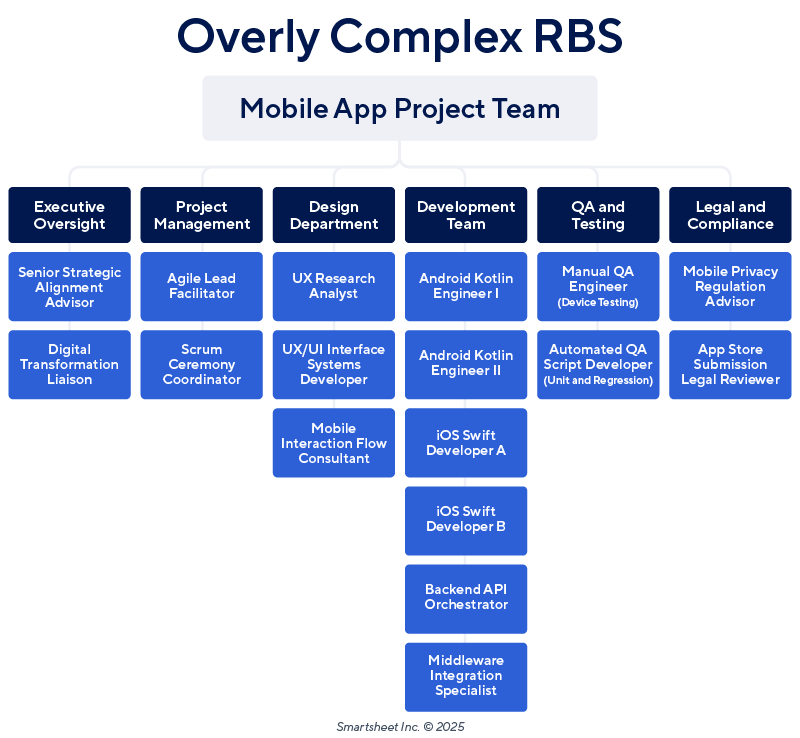
Notice how this diagram is overloaded with unnecessary complexity. It breaks roles down into overly granular distinctions — such as having multiple Android engineers with different numbers. This clutters the structure without adding meaningful clarity.
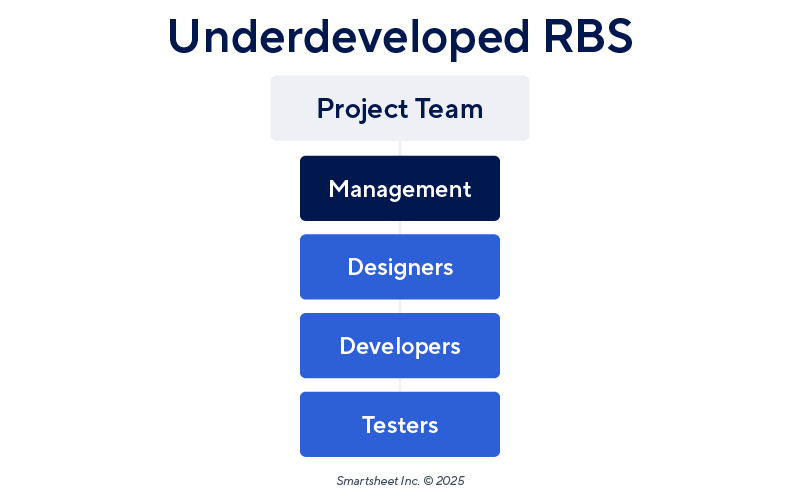
This RBS is too vague to be useful. It lumps broad functions such as Designers and Developers into single categories without distinguishing between roles such as UX and UI, or front end and back end. This lack of detail makes it hard to identify resource gaps.
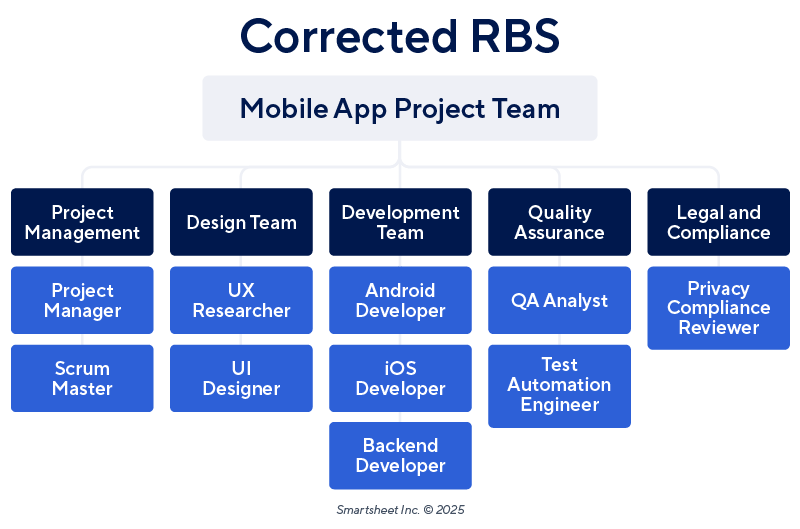
By providing enough detail to clarify roles and responsibilities without overwhelming the viewer, this RBS strikes the right balance. Unlike the first chart, it avoids redundant subcategories and overly specific job titles, sticking to clear, commonly understood roles. Unlike the second chart, it separates key functions — such as UX and UI design, or Android and iOS development — so that responsibilities are clear.
Resource Breakdown Structure Examples and Templates by Industry
An RBS should be tailored to the needs of your industry and project type. Whether you’re managing a federal government initiative or launching a marketing campaign, the categories and resources will vary. Below, you’ll find examples of RBS charts across major industries, plus free, downloadable templates to get you started.
Simple Resource Breakdown Structure Template

Download the Simple Resource Breakdown Structure Template for Excel
Use this RBS template during the planning phase of a project to create a simple, customizable tree diagram of your required resources. It includes four default branches — human, equipment, materials, and services — but you can easily add or remove categories and resource boxes as needed. Follow our step-by-step guide to creating an RBS to make it your own.
Software Development Example RBS
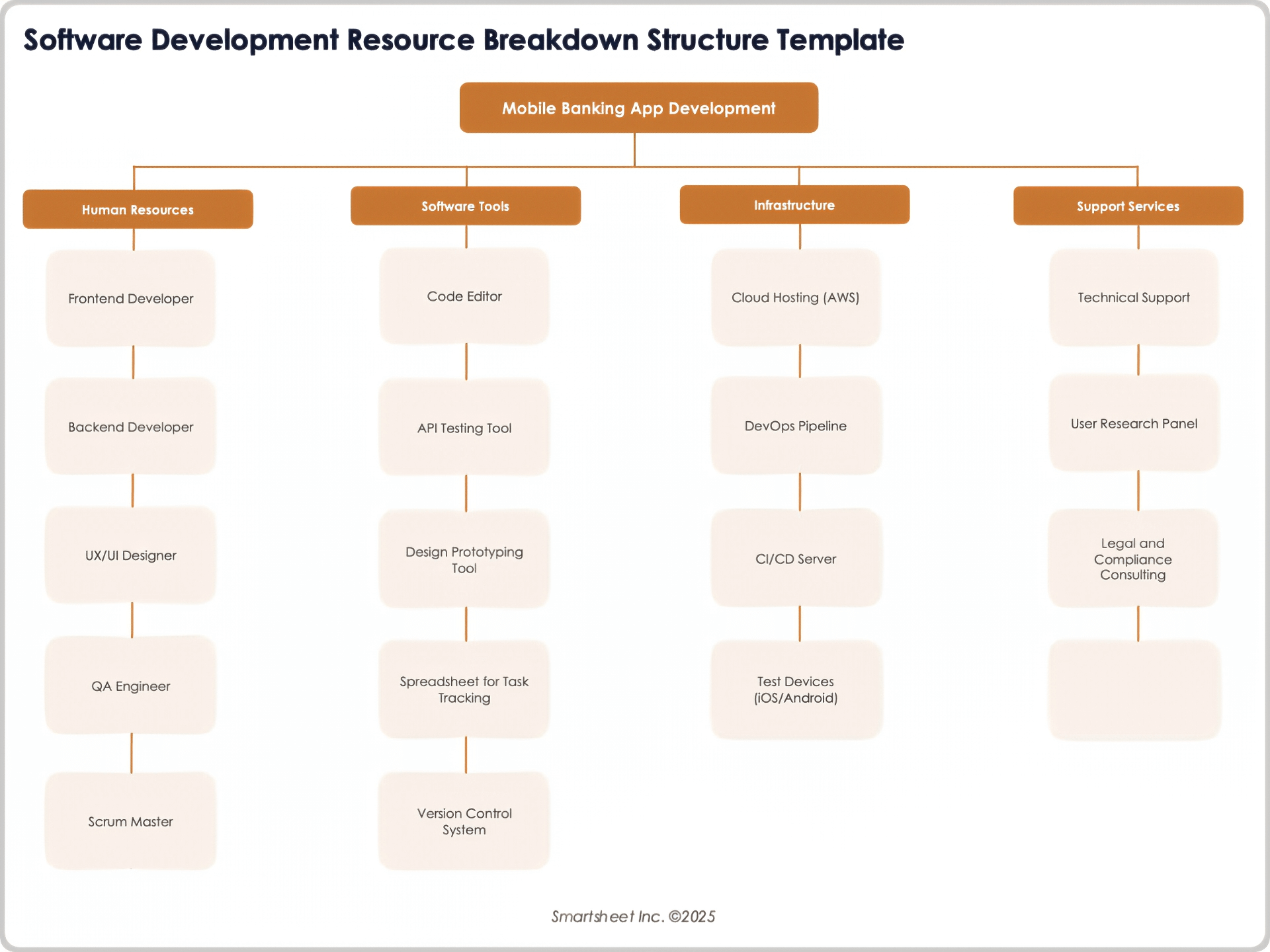
Download the Software Development Resource Breakdown Structure Template for Excel
Use this template during the planning phase of a software project to visually organize key resource types. It includes sample data for a mobile banking app development project, with branches for human resources, tools, infrastructure, and support services, but you can customize it with categories and resources to match your project’s needs.
Example Marketing Campaign Resource Breakdown Structure
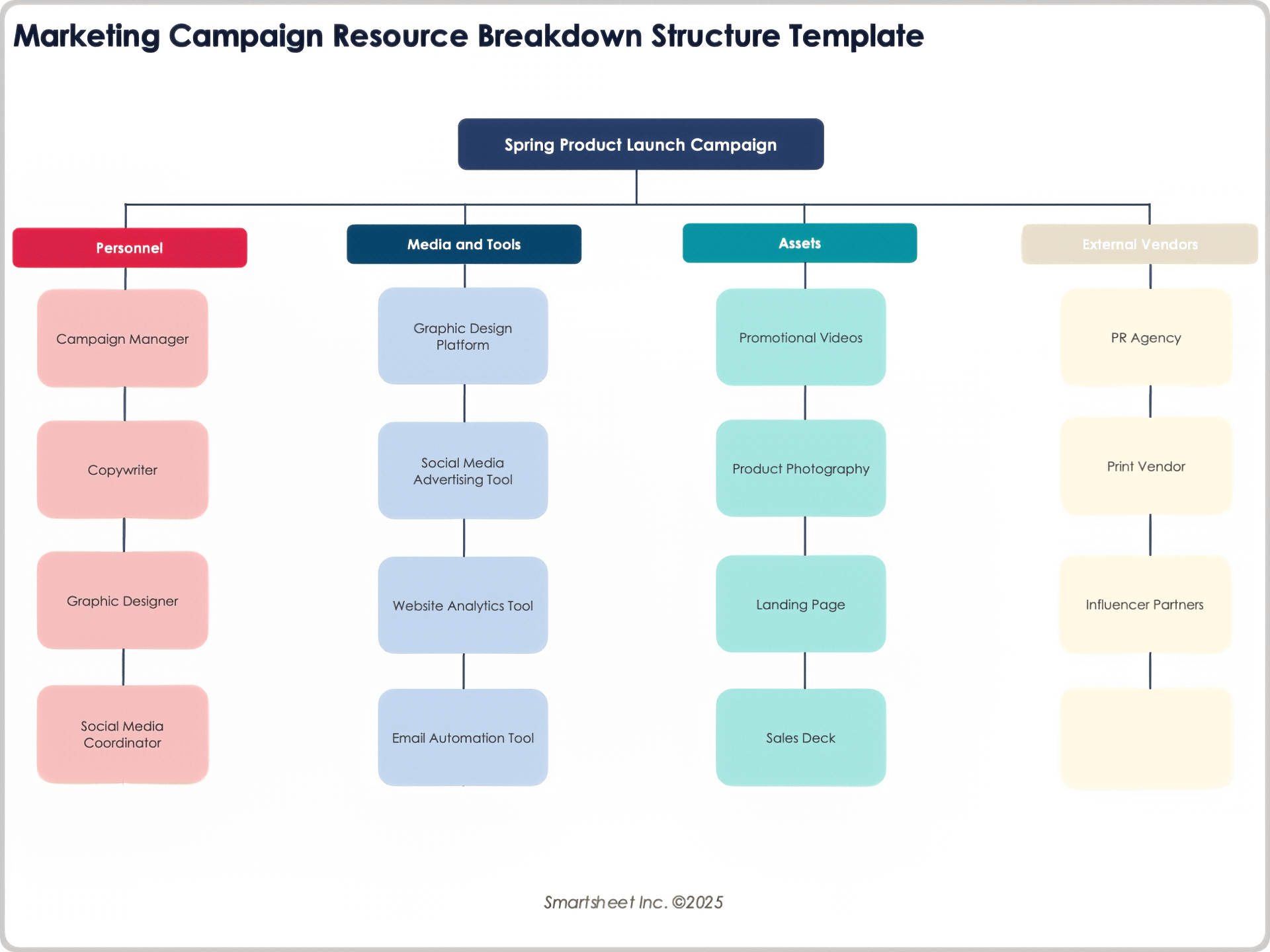
Download the Marketing Campaign Resource Breakdown Structure Template for Excel
This RBS diagram features example resources for a product launch, organized into color-coded categories: personnel, media and tools, assets, and external vendors. The template is fully customizable, so you can adjust resource types and entries to suit any marketing campaign.
Healthcare Industry RBS Example

Download the Healthcare Industry Resource Breakdown Structure Template for Excel
For teams that prefer scanning left to right to track responsibilities across departments, this horizontally oriented RBS template is ideal. Pre-filled with data for a patient portal pilot launch, it is easily customizable to any project in healthcare or other industries.
Sample Construction Resource Breakdown Structure
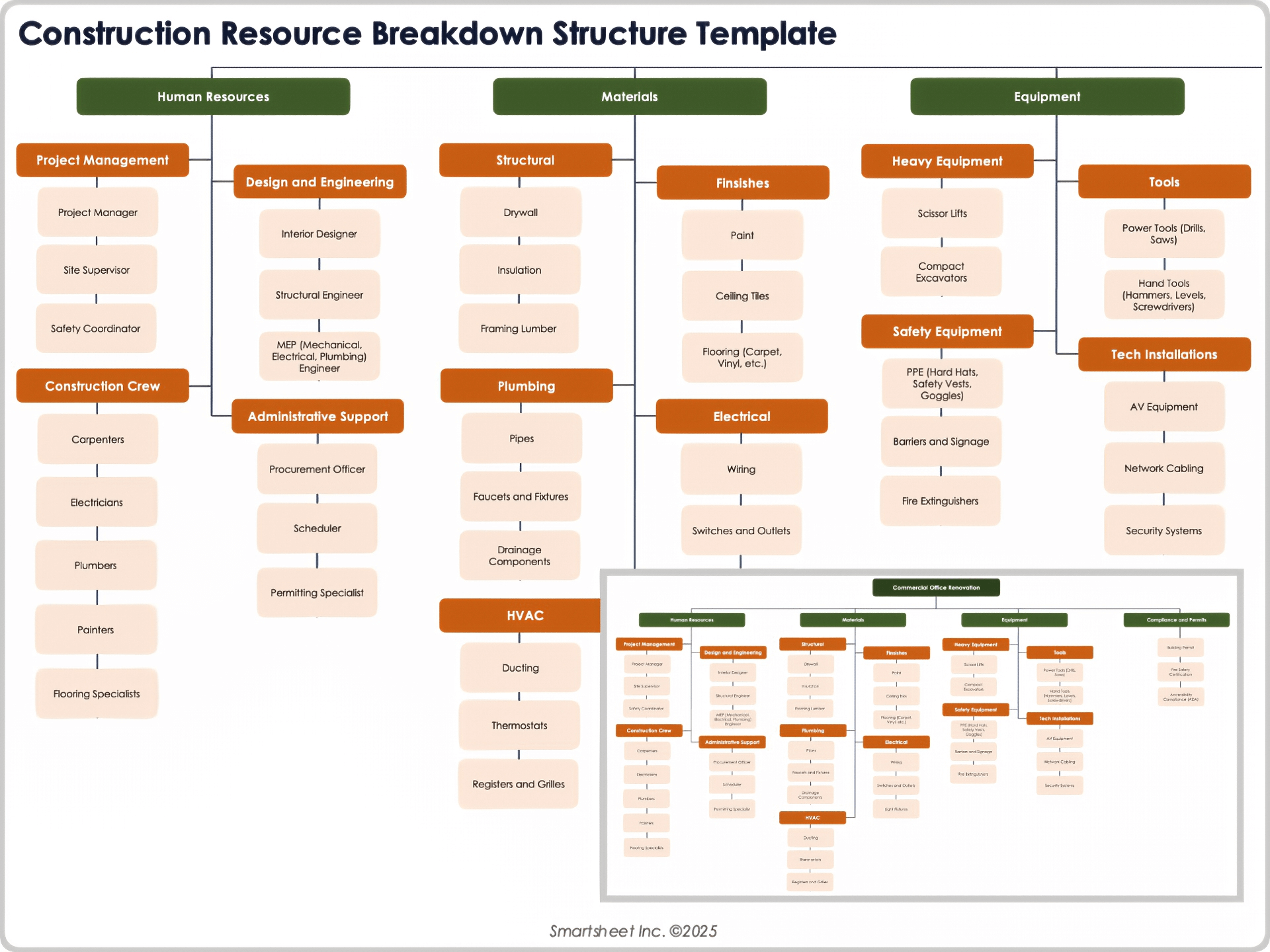
Download the Construction Resource Breakdown Structure Template for Excel
This RBS template includes an additional layer of subcategories, so it’s perfect for more complex projects with many moving parts, such as construction or manufacturing projects. It comes pre-filled with sample resources for a commercial office renovation. Instead of simply listing building materials, it separates them into more specific categories: structural, finishes, plumbing, electrical, and HVAC. This extra level of detail provides a cleaner, more intuitive visual.
Example RBS for Federal Government

Download the Federal Government Resource Breakdown Structure Template for Excel
This RBS template for a federal cybersecurity upgrade project includes customizable categories — such as personnel, technology, and training — to suit government-specific needs.
Example RBS for Professional Services

Download the Professional Services Breakdown Structure Template for Excel
Use this horizontally oriented RBS template to map the resources involved in a client rebranding project. With categories such as Consulting Staff, Tools and Platforms, and Client Deliverables, this template helps professional services teams identify both internal needs and resources that must be acquired or approved by the client to keep the project moving forward.
RBS for Education Example

Download the Education Resource Breakdown Structure Template for Excel
This radially oriented resource breakdown structure offers a visually eye-catching way to present the key components of an education project. The resource categories radiate from a central project node, which makes it especially effective for presentations.
Example RBS for Finance
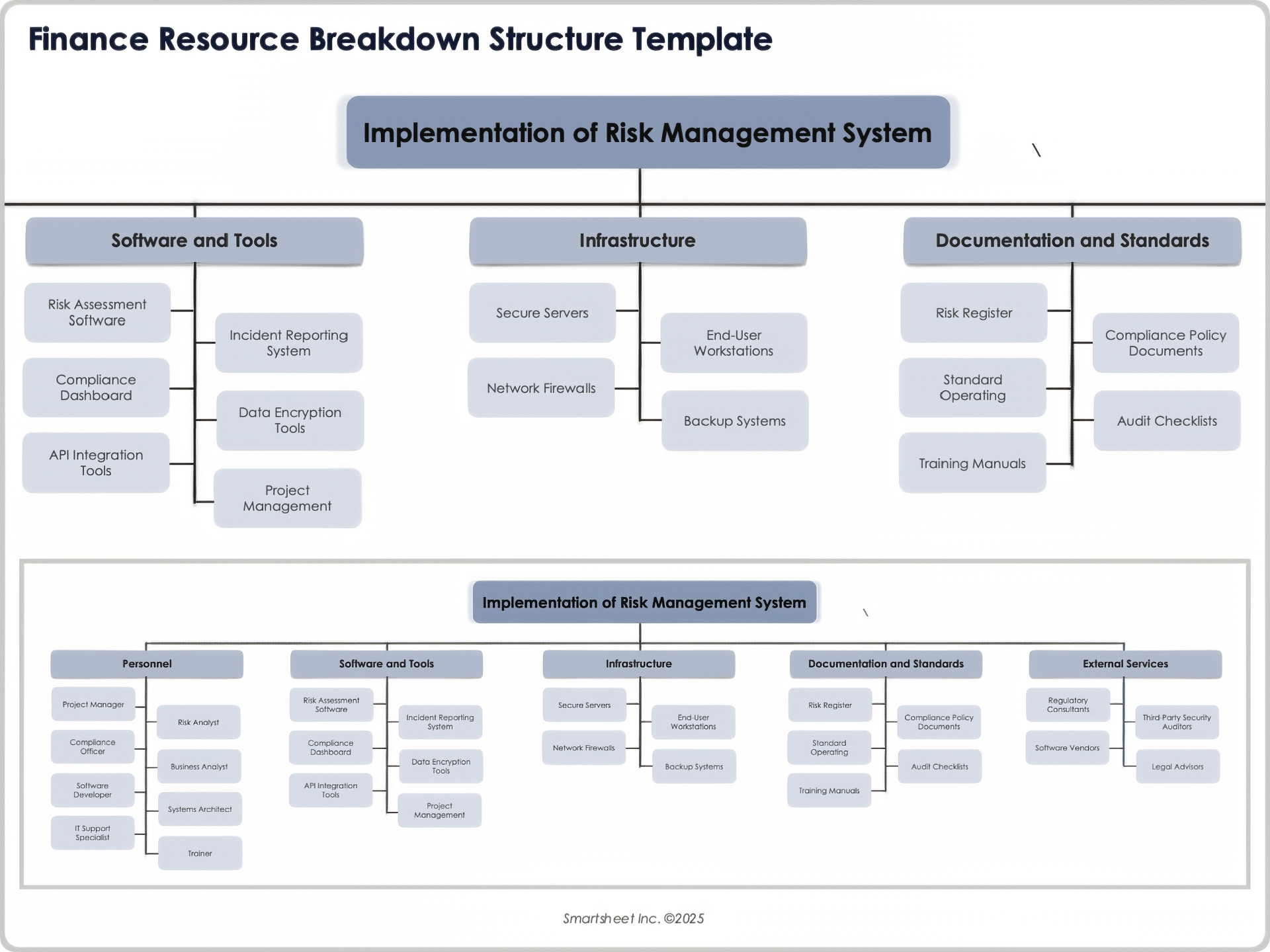
Download the Finance Resource Breakdown Structure Template for Excel
This template includes more resource boxes than most, which makes it a great fit for complex projects with a wide range of resource needs, such as finance-related initiatives. The pre-filled categories include personnel, tools, infrastructure, documentation, and external services. Simply replace the sample data with your own to customize the template.
Create a Strong, Visually Engaging Resource Breakdown Structure With Smartsheet for Project Management
Resource Management by Smartsheet is a powerful resource management software that helps to effectively manage the who, the what, and the when behind projects.
With Resource Management by Smartsheet, you can more easily build the best team for a project, keep project schedules and budgets on track, and confidently forecast business needs.
When teams have clarity into the work getting done and by whom, there’s no telling how much more they can accomplish in the same amount of time. Watch a free demo to learn more about Resource Management by Smartsheet.